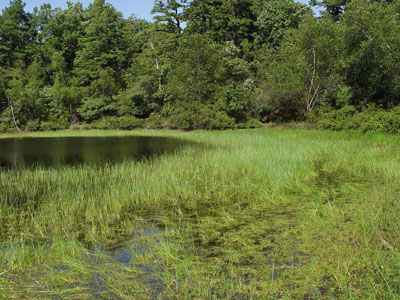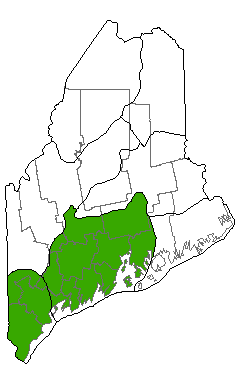DACF Home → Bureaus & Programs → Maine Natural Areas Program → Communities, Plants, and Animals → Natural Community Fact Sheets → Outwash Plain Pondshore
Printer Friendly Fact Sheet - 980 KB pdf (Get a free copy of Adobe Acrobat Reader)
Outwash Plain Pondshore
Scientific Name: Three-way Sedge - Goldenrod Outwash Plain Pondshore; State Rank: S1

- Community Description
- Soil and Site Characteristics
- Diagnostics
- Similar Types
- Conservation, Wildlife and Management Considerations
- Distribution
- Characteristic Plants
- Associated Rare Plants
- Associated Rare Animals
- Examples on Conservation Lands You Can Visit
Community Description: This community consists of concentric zones of different herbs around a central pond. A band of shrubs (highbush blueberry, maleberry, buttonbush, leatherleaf) is typical at the upland/pondshore edge. Moving pondward, the next zone is dominated by narrow-leaved goldenrod and three-way sedge, with patches of flat-sedge and brown-fruited rush. In a narrow band at the top of this zone, golden pert and meadow beauty are characteristic and may form dense patches. The next zone, exposed less frequently and for a shorter time, is dominated by pipewort and spikerushes. There is no well developed bryoid layer. Back to top.
Soil and Site Characteristics: This community forms a band around the perimeter of shallow, sandy bottomed ponds in glacial outwash plains. It occurs on shores that are inundated for the early part of the growing season and exposed later in the growing season, although actual exposure varies from year to year. The substrate is sandy, occasionally mucky, and usually saturated to the surface or nearly so. Back to top.
Diagnostics: Three-way sedge and usually narrow-leaved goldenrod are dominant in a sandy pondshore setting, with evidence of water level changes through the season. Golden pert and meadow beauty are indicator species. Back to top.
Similar Types: Grassy Shrub Marshes can also occur on temporarily flooded mineral soils and can share some dominants such as three-way sedge, but they lack the concentric zonation of outwash plain pondshores and typically intermingle shrubs and herbs rather than segregating them into zones. The more variable and widespread Lakeshore Beaches lack three-way sedge, golden pert and meadow beauty. Back to top.
Conservation, Wildlife and Management Considerations: This extremely rare natural community is under pressure from adjacent land uses and recreational impacts. The periphery of several sites has been developed or converted to other uses. At the few known sites on conservation lands, the major recreational impact is off-road vehicle use. At low water, ATV use has significantly altered the vegetation at some sites. Hydrologic integrity is also a concern; as water use increases from neighboring homes and businesses, aquifer drawdowns could impair these water dependent systems and lead to vegetational changes.
These outwash plain pondshores provide excellent foraging habitat for the ribbon snake. The pondshores also provide habitat for the big bluet, a rare damselfly. Other more wide-ranging rare insects are likely to be found in this community. At sites close to the coast, this community may also provide important feeding habitat for rare wading birds such as the little blue heron. Back to top.
Distribution: Extreme southwestern Maine (Eastern Broadleaf Forest Province), extending southward along the coast to Massachusetts; disjunct in Nova Scotia and Ontario. Landscape Pattern: Small Patch. Back to top.


Characteristic Plants: These plants are frequently found in this community type. Those with an asterisk are often diagnostic of this community.
- Herb
- Bluejoint*
- Brown-fruited rush*
- Bur-reed*
- Canada rush
- Fly-away grass
- Golden pert*
- Narrow-leaved goldenrod*
- Pipewort*
- Robbin's spikerush*
- Three-way sedge
- Toothed flat-sedge*
- Yellow loosestrife
- Dwarf bulrush
- Englemann's spikerush
- Fall fimbry
- Huron tansy
- Long-tubercled spike-rush
- Narrow-leaved goldenrod
- Big bluet
- Ribbon snake
Examples on Conservation Lands You Can Visit
| Example | County |
|---|---|
| Killick Pond Wildlife Management Area | York Co. |
| Waterboro Barrens Preserve | Oxford Co. |